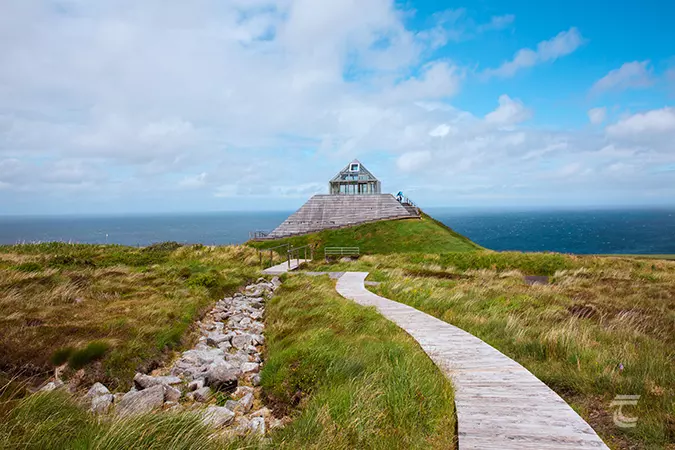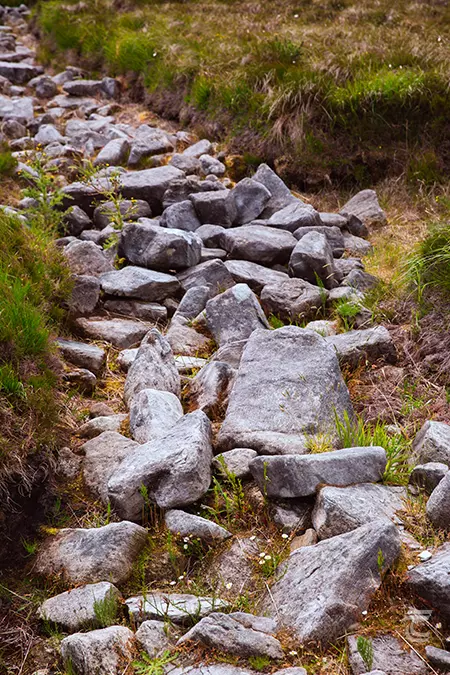Céide Fields Visitor Centre
For millennia, the bleak blanket bog along the wild coast of North Mayo hid a fascinating system of field walls, enclosures and monuments that was created over 5,000 years ago in the Neolithic period. The walls had first been noted by a local schoolteacher, Patrick Caulfield. His son, the renowned archaeologist Seamus Caulfield, carried out a groundbreaking programme of excavation and survey that revealed one of the most important prehistoric landscapes in Ireland. This landscape has become known as the Céide Fields. The award winning Céide Fields Visitor Centre and excellent OPW guides help to tell this remarkable story.
This landscape is of great importance, as although a number of Neolithic tombs can still be seen around the country, there are few places where you can experience a sense of the broader agricultural landscape dating back to this period. This gives incredible insight into the farming practice and daily life of Ireland’s earliest farmers. From the complex of field systems we can infer that they were created by a society that must have involved close co-operation by a large number of people to fell the forests, clear the fields and build the walls. Their religious beliefs can be seen in the megalithic tombs that were also discovered during the survey, along with a number of houses that give an indication of how they lived.
A number of the plots discovered within the Céide Fields complex are very large by contemporary Irish standards, with enclosed areas of up to several hectares in size. This suggests livestock husbandry rather than tillage, and that they may have been used as cattle pasture. By analysing the pollen trapped within the ancient soil, some of the smaller fields, like the ones close to the Céide Fields Visitor Centre, are believed to have been used to grow cereal, including early species like Emmer Wheat. During the Neolithic period the climate would have been both drier and warmer. Once the forests of pine, birch, hazel and oak had been felled, this landscape was ideal for agriculture. Over millennia the climate has changed, and became both colder and wetter, allowing for the development of the blanket bog that has sealed and preserved much of this fascinating ancient landscape.
For practical information about visiting this site Click Here
For millennia, the bleak blanket bog along the wild coast of North Mayo hid a fascinating system of field walls, enclosures and monuments that was created over 5,000 years ago in the Neolithic period. The walls had first been noted by a local schoolteacher, Patrick Caulfield. His son, the renowned archaeologist Seamus Caulfield, carried out a groundbreaking programme of excavation and survey that revealed one of the most important prehistoric landscapes in Ireland. This landscape has become known as the Céide Fields. The award winning Céide Fields Visitor Centre and excellent OPW guides help to tell this remarkable story.
This landscape is of great importance, as although a number of Neolithic tombs can still be seen around the country, there are few places where you can experience a sense of the broader agricultural landscape dating back to this period. This gives incredible insight into the farming practice and daily life of Ireland’s earliest farmers. From the complex of field systems we can infer that they were created by a society that must have involved close co-operation by a large number of people to fell the forests, clear the fields and build the walls. Their religious beliefs can be seen in the megalithic tombs that were also discovered during the survey, along with a number of houses that give an indication of how they lived.
A number of the plots discovered within the Céide Fields complex are very large by contemporary Irish standards, with enclosed areas of up to several hectares in size. This suggests livestock husbandry rather than tillage, and that they may have been used as cattle pasture. By analysing the pollen trapped within the ancient soil, some of the smaller fields, like the ones close to the Céide Fields Visitor Centre, are believed to have been used to grow cereal, including early species like Emmer Wheat. During the Neolithic period the climate would have been both drier and warmer. Once the forests of pine, birch, hazel and oak had been felled, this landscape was ideal for agriculture. Over millennia the climate has changed, and became both colder and wetter, allowing for the development of the blanket bog that has sealed and preserved much of this fascinating ancient landscape.
For practical information about visiting this site Click Here

The Céide Fields Visitor Centre • Mayo
How old are the Céide Fields?

Ancient bog pine in the visitor centre • Mayo
After a dispute that brought the period of the site into question, the date of the field system was recently confirmed by a study carried out by the Palaeoenvironmental Research Unit at NUI Galway that demonstrated that the Céide Fields date back to the early Neolithic, with activity as early as 3800 BC. Establishing the site as one of the best preserved ancient farming landscapes not only in Ireland but in Europe, thanks to the extensive growth of blanket bog that covered, and preserved these landscapes.
The research was carried out by NUI Galway’s Professor Michael O’Connell, Dr Karen Molloy and Dr Eneda Jennings, and was recently published in the international journal E&G Quaternary Science Journal. Professor Michael O’Connell, Professor Emeritus at NUI Galway, said:
“This new research not only confirms the early Neolithic age of the field systems but also leaves no doubt as to the intensity of the initial phase of Neolithic farming in north Mayo. This started at 3800 BC and lasted for 400 years. Not only was it of long duration, but the fossil pollen data, provided by pollen analyst, Dr Karen Molloy, at NUI Galway, suggests that it was more intensive than any farming of Neolithic age so far recorded in Ireland or Britain.”
The remote past is ever present in County Mayo.

Ancient bog pine in the visitor centre • Mayo
Upper left: Wooden walkways and ancient walls • Lower left: in the visitor centre exhibition • Right: a Neolithic wall
Top: Wooden walkways and ancient walls • Middle: a Neolithic wall • Bottom: in the visitor centre exhibition
Explore more sites along the Wild Atlantic Way






